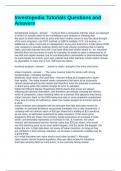Investopedia Tutorials Questions and
Answers
fundamental analysis - answer trying to find a companies intrinsic value, as opposed
to what it is actually worth in the marketplace your analysis is showing that
the stock is worth more than its price and that it makes sense to buy the stock.thought
of for more long term. use DCF method. or EBITA multiple, FCF, net income.. in
additional to value, must look at management, know your business's model (know HOW
your company is actually making money don't just choose something that is trading
high), and what industry they are in too (and what their market share is-- ex. microsoft
benefits from and economy of scale for example, its easier to open a restaurant bc of
low skill and capital needed, but for something like a automobile or pharmeuticals think
its much harder bc of tech, govt regs, patents and other barriers). brand names should
be diversified, in case one is hurt, still have the others.
technical analysis - answer trends in charts. thought of for more short term.
Value Investing - answer The value investor looks for stocks with strong
fundamentals - including earnings,
dividends, book value, and cash flow - that are selling at a bargain price, given
their quality. The value investor seeks companies that seem to be incorrectly
valued (undervalued) by the market and therefore have the potential to increase
in share price when the market corrects its error in valuation.
While the Efficient Market Hypothesis (EMH) claims that prices are always
reflecting all relevant information, and therefore are already showing the intrinsic
worth of companies, value investing relies on a premise that opposes that theory.
Value investors bank on the EMH being true only in some academic wonderland.
They look for times of inefficiency, when the market assigns an incorrect price to
a stock.
Value investors also disagree with the principle that high beta (also known as
volatility, or standard deviation) necessarily translates into a risky investment. A
company with an intrinsic value of $20 per share but is trading at $15 would be,
as we know, an attractive investment to value investors. If the share price
dropped to $10 per share, the company would experience an increase in beta,
which conventionally represents an increase in risk. If, however, the value
investor still maintained that the intrinsic value was $20 per share, s/he would
see this declining price as an even better bargain. And the better the bargain, the
lesser the risk. A high beta does not scare off value investors. As long as they
are confident in their intrinsic valuation, an increase in downside volatility may be
a good thing.
b) In what industries are value stocks most often located? - Although
value stocks can be located anywhere, they are often located in industries
that have recently fallen on hard times, or are currently facing market
, overreaction to
The Margin of Safety - answer A discussion of value investing would not be complete
without mentioning the
use of a margin of safety, a technique which is simple yet very effective.
Consider a real-life example of a margin of safety. Say you're planning a
pyrotechnics show, which will include flames and explosions. You have
concluded with a high degree of certainty that it's perfectly safe to stand 100 feet
from the center of the explosions. But to be absolutely sure no one gets hurt, you
implement a margin of safety by setting up barriers 125 feet from the explosions.
This use of a margin of safety works similarly in value investing. It's simply the
practice of leaving room for error in your calculations of intrinsic value. A value
investor may be fairly confident that a company has an intrinsic value of $30 per
share. But in case his or her calculations are a little too optimistic, he or she
creates a margin of safety/error by using the $26 per share in their scenario
analysis. The investor may find that at $15 the company is still an attractive
investment, or he or she may find that at $24, the company is not attractive
enough. If the stock's intrinsic value is lower than the investor estimated, the
margin of s
growth investing - answer The best way to define growth investing is to contrast it to
value investing. Value
investors are strictly concerned with the here and now; they look for stocks that,
at this moment, are trading for less than their apparent worth. Growth investors,
on the other hand, focus on the future potential of a company, with much less
emphasis on its present price. Unlike value investors, growth investors buy
companies that are trading higher than their current intrinsic worth - but this is
done with the belief that the companies' intrinsic worth will grow and therefore
exceed their current valuations.
The NAIC
The National Association of Investors Corporation (NAIC) is one of the best
known organizations using and teaching the growth investing strategy. It is, as it
says on its website, "one big investment club" whose goal is to teach investors
how to invest wisely. The NAIC has developed some basic "universal" guidelines
for finding possible growth companies - here's a look at some of the questions
the NAIC suggests you should ask when considering stocks.
1. Strong Historical Earnings Growth?
According to the NAIC, the first question a growth investor should ask is
whether the company, based on annual revenue, has been growing in the
past. Below are rough guidelines for the rate of EPS growth an investor
Investopedia.com - Your Source For Investing Education.
This tutorial can be found at: http://www.investopedia.com/university/stockpicking/
(Page 15 of 36)
Copyright © 2010, Investopedia.com - All rights reserved.
should look for in companies of differing sizes, which would indicate their
growth investing potential:




